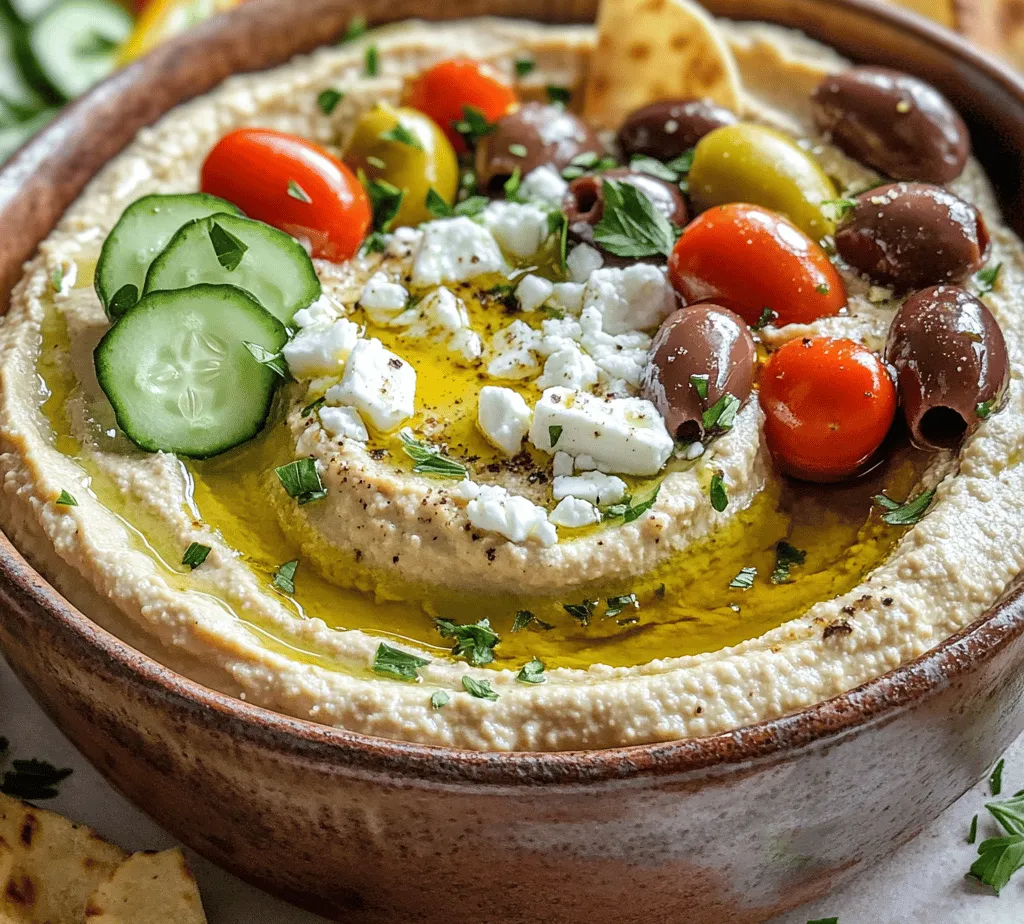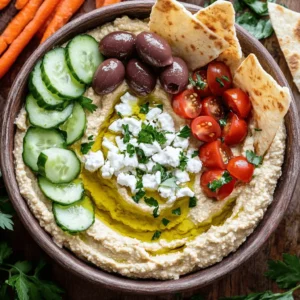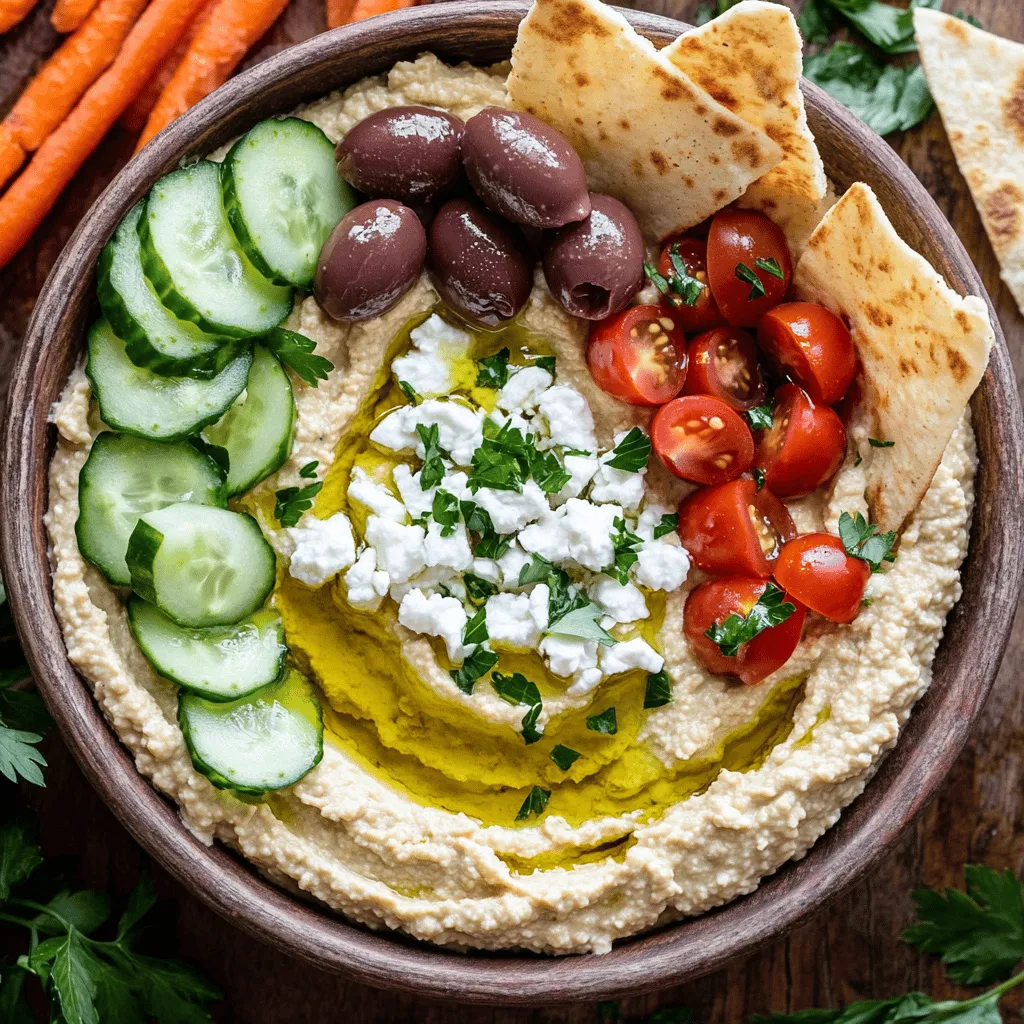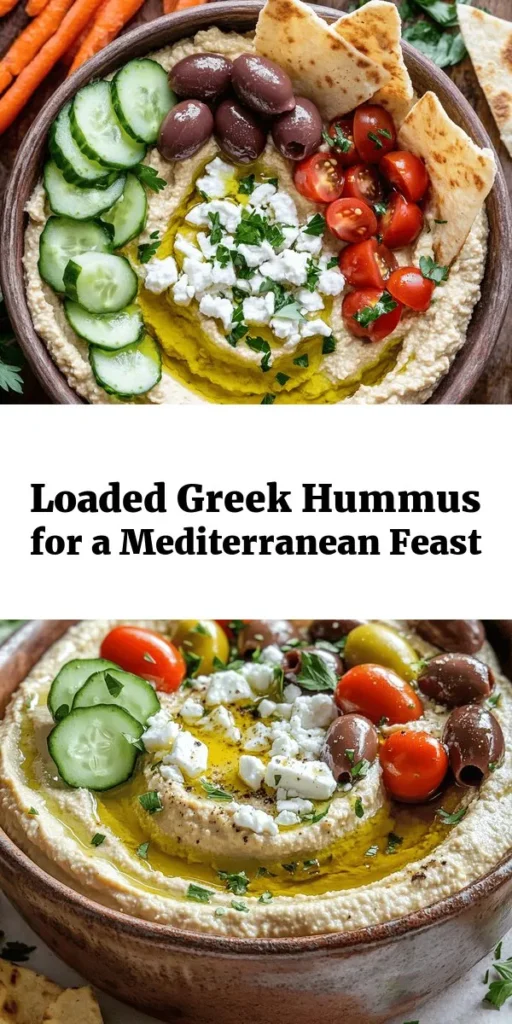Introduction
Hummus has taken the culinary world by storm, garnering a dedicated following among food enthusiasts for its rich flavor, creamy texture, and numerous health benefits. This classic Middle Eastern dip, made primarily from chickpeas, has become a beloved staple in kitchens around the globe. The rise of plant-based diets has only further solidified its place as a nutritious and versatile option in both casual and gourmet meals. What’s more, hummus can be enjoyed in a variety of ways, whether served with pita bread, fresh vegetables, or as a flavorful spread in wraps and sandwiches.
Today, we’re diving into a delectable variation of this popular dish: Greek Style Loaded Hummus. This recipe elevates traditional hummus by incorporating quintessential Greek ingredients, offering a vibrant burst of flavors that tantalizes the taste buds. Picture a smooth, creamy base of hummus topped with fresh vegetables, tangy feta cheese, and the briny goodness of Kalamata olives. This dish not only serves as an excellent appetizer but also embodies the essence of the Mediterranean diet, which emphasizes fresh, wholesome ingredients and balanced nutrition.
The Mediterranean diet is celebrated for its health benefits, promoting heart health, weight management, and overall well-being. Its focus on fruits, vegetables, whole grains, healthy fats, and lean proteins aligns perfectly with the principles of a balanced lifestyle. With Greek Style Loaded Hummus, you can indulge in the delightful flavors of the Mediterranean while reaping its nutritional rewards.
Understanding Hummus: A Mediterranean Staple
Hummus has a rich history that dates back centuries, with origins believed to be rooted in the Mediterranean region, particularly in countries such as Lebanon, Israel, and Turkey. Though its exact beginnings are debated, what remains undisputed is the enduring popularity of this dish across various cultures. Traditionally made from cooked and mashed chickpeas, tahini (a paste made from ground sesame seeds), olive oil, lemon juice, and garlic, hummus is not only a delicious dip but also a symbol of cultural heritage and communal dining.
Nutritionally, hummus is a powerhouse. Chickpeas are the star ingredient, offering an impressive array of health benefits. They are a fantastic source of plant-based protein, making them an ideal choice for vegetarians and vegans. Chickpeas are also rich in dietary fiber, which aids in digestion and supports heart health by helping to lower cholesterol levels. Additionally, they contain essential vitamins and minerals such as folate, iron, and magnesium.
Tahini, another key component of hummus, contributes both flavor and texture. This creamy paste is packed with healthy fats, protein, and minerals like calcium, making it a nutritious addition to any dish. The combination of chickpeas and tahini creates a synergistic effect, enhancing the overall nutritional profile of hummus.
The Mediterranean diet, from which hummus originates, is widely regarded as one of the healthiest eating patterns in the world. This diet emphasizes the consumption of whole, minimally processed foods, with a focus on fresh fruits and vegetables, whole grains, healthy fats (particularly olive oil), and lean proteins, such as fish and legumes. Research has consistently shown that following a Mediterranean diet is associated with numerous health benefits, including reduced risk of chronic diseases, improved heart health, and better cognitive function. By enjoying Greek Style Loaded Hummus, you can not only satisfy your taste buds but also contribute to your overall health and wellness.
Key Ingredients for Greek Style Loaded Hummus
To create the perfect Greek Style Loaded Hummus, it’s essential to select high-quality ingredients that will elevate the dish’s flavor and nutritional value. Let’s take a closer look at the key components of this delightful recipe:
Chickpeas
Chickpeas serve as the foundation of any hummus recipe, providing a creamy texture and rich flavor. Nutritionally, chickpeas are an excellent source of plant-based protein, making them a perfect option for those looking to incorporate more meatless meals into their diet. They are also high in dietary fiber, which promotes satiety, aids digestion, and helps maintain stable blood sugar levels. Additionally, chickpeas are rich in essential vitamins and minerals, including folate, iron, and magnesium, making them a nutrient-dense choice.
Tahini
Tahini is a crucial ingredient that adds depth and creaminess to hummus. This paste, made from ground sesame seeds, is not only delicious but also boasts a wealth of health benefits. Tahini is rich in healthy fats and provides a good source of protein. It is also packed with essential nutrients such as calcium, iron, and magnesium. When blended with chickpeas and other ingredients, tahini contributes to the smooth and velvety texture that is characteristic of a well-made hummus.
Olive Oil
In Mediterranean cooking, olive oil is a quintessential ingredient known for its flavor and health benefits. When selecting olive oil for your Greek Style Loaded Hummus, opt for high-quality extra virgin olive oil, which is cold-pressed and retains the most nutrients. Olive oil is rich in monounsaturated fats, which are heart-healthy and may help reduce inflammation. Additionally, it contains antioxidants, such as vitamin E and polyphenols, which can contribute to overall health. A drizzle of olive oil on top of the hummus not only enhances the dish’s flavor but also adds a beautiful finishing touch.
Greek Yogurt
Greek yogurt is a fantastic addition to Greek Style Loaded Hummus, providing creaminess and a boost of protein. This thick and tangy yogurt is lower in sugar and higher in protein compared to regular yogurt, making it a nutritious option. It also contains probiotics, which are beneficial for gut health. For those seeking a dairy-free alternative, consider using a plant-based yogurt made from almond or coconut milk, ensuring that it is unsweetened and unflavored to keep the hummus true to its savory roots.
Fresh Vegetables
Fresh vegetables play a vital role in creating a colorful and nutritious topping for Greek Style Loaded Hummus. Ingredients such as cucumbers, cherry tomatoes, and parsley not only add vibrant colors but also enhance the dish’s freshness. Cucumbers provide a crisp texture and hydration, while cherry tomatoes offer a burst of sweetness. Parsley, a popular herb in Mediterranean cuisine, adds a hint of earthiness and brightness, making the hummus even more appealing.
Kalamata Olives and Feta Cheese
Kalamata olives and feta cheese are two iconic ingredients that can elevate Greek Style Loaded Hummus to new heights. Kalamata olives, known for their deep purple color and rich flavor, add a briny, savory element that complements the creaminess of the hummus. They are also a source of healthy fats and antioxidants. Feta cheese, with its tangy and salty profile, brings a delightful creaminess to the dish. If you are looking for a dairy-free option, consider omitting the feta or using a vegan feta substitute, which can provide similar flavors without the dairy.
Step-by-Step Guide to Preparing Greek Style Loaded Hummus
Now that you’re familiar with the key ingredients for Greek Style Loaded Hummus, it’s time to dive into the preparation process. Follow these detailed steps to create a delicious and visually appealing dish that will impress your family and friends.
Preparation of Ingredients
Before you start making your hummus, it’s important to prepare your ingredients properly. Begin by rinsing and draining the canned chickpeas under cold water. This helps remove excess sodium and any residual canning liquid, ensuring a cleaner taste. If you have the time, you can also opt for dried chickpeas; however, they will require soaking and cooking beforehand.
Next, chop your fresh vegetables. Dice the cucumbers into small pieces, slice the cherry tomatoes in half, and finely chop the parsley. Set these aside for later assembly. If you’re using Kalamata olives, slice them in half to make them easier to eat and distribute on top of the hummus.
Making the Hummus in a Food Processor
Once your ingredients are prepped, it’s time to make the hummus! In a food processor, combine the rinsed chickpeas, tahini, olive oil, Greek yogurt, lemon juice, garlic (if desired), and a pinch of salt. Blend until smooth and creamy. If the mixture appears too thick, you can add a small amount of water or additional olive oil to achieve your desired consistency. The key is to blend thoroughly, allowing the food processor to work its magic on the chickpeas and tahini, creating a silky-smooth texture.
Tips for Achieving the Perfect Texture and Flavor Balance
To ensure your Greek Style Loaded Hummus has the perfect flavor balance, taste the mixture before serving. Adjust the seasoning as needed by adding more salt, lemon juice, or olive oil, depending on your preference. A well-balanced hummus should have a harmonious blend of creaminess, a hint of tanginess from the lemon juice, and a touch of richness from the olive oil.
Once you’ve achieved the desired flavor and texture, transfer the hummus to a serving dish. Smooth the top with a spatula, creating a small well in the center to hold the toppings. Drizzle additional olive oil over the surface, then artfully arrange the chopped cucumbers, halved cherry tomatoes, Kalamata olives, and crumbled feta cheese on top. Finish with a sprinkle of fresh parsley for an added burst of color and flavor.
With these steps, your Greek Style Loaded Hummus will not only be a feast for the palate but also a visual delight. This dish is perfect for gatherings, picnics, or simply as a healthy snack at home, showcasing the vibrant flavors of the Mediterranean. Enjoy your culinary creation and share the experience with friends and family, allowing them to savor the taste of Mediterranean bliss.

Instructions for Assembling the Loaded Hummus Presentation
Creating a stunning presentation for your Greek Style Loaded Hummus not only enhances its visual appeal but also elevates the dining experience. Follow these simple steps to assemble your dish beautifully:
1. Prepare the Base: Start by transferring your smooth and creamy hummus to a large serving platter or a shallow bowl. Use the back of a spoon to create a slight well in the center, which will hold your toppings and add depth to the presentation.
2. Layer the Toppings: Begin layering your toppings in the well you created. Start with a generous drizzle of high-quality olive oil, allowing it to pool in the center. This not only adds flavor but also creates a beautiful sheen that catches the eye.
3. Add Fresh Ingredients: Next, sprinkle a handful of chopped cherry tomatoes, diced cucumber, and red onion over the hummus. These ingredients add a vibrant burst of color and freshness, embodying the essence of Mediterranean cuisine.
4. Incorporate Proteins: For added texture and nutrition, scatter crumbled feta cheese or kalamata olives on top. These ingredients provide a salty contrast to the creamy hummus, making each bite an explosion of flavors.
5. Garnish: Finish off your presentation with a sprinkle of fresh herbs, such as chopped parsley or dill. A few pinches of smoked paprika or za’atar can also add a pop of color and an aromatic touch.
6. Final Drizzle: For an extra touch of elegance, drizzle more olive oil over the entire dish. This creates a glossy finish and enhances the flavor profile.
7. Serve Immediately: Once assembled, serve your Greek Style Loaded Hummus immediately to ensure freshness and vibrant colors.
Serving Suggestions for Greek Style Loaded Hummus
This loaded hummus is a versatile dish that can be served in a variety of exciting ways. Here are some creative serving ideas to enhance your dining experience:
– Creative Ideas for Serving: While hummus can be enjoyed straight from the bowl, consider presenting it as part of a larger spread. Pair it with an array of colorful pita chips, crunchy fresh vegetables, or even crispy flatbreads. This not only enhances the flavor but also encourages sharing and interaction among guests.
– Pairing with Pita Chips vs. Fresh Vegetables: Pita chips offer a satisfying crunch that complements the smooth texture of the hummus. They are perfect for scooping and carry a slightly toasted flavor that enhances the overall dish. Alternatively, fresh vegetables such as carrot sticks, bell pepper strips, and cucumber slices provide a refreshing contrast, making the dish lighter and more health-conscious.
– Garnishing Options for a Visually Appealing Presentation: To create an eye-catching presentation, consider garnishing your hummus with edible flowers, thin slices of radish, or a mix of colorful microgreens. These additions not only elevate the visual appeal but also add unique flavors to the dish.
– Ideas for Incorporating into Meals: Greek Style Loaded Hummus is not just a dip; it can also be incorporated into meals. Serve it as a dip at gatherings alongside other mezze dishes, making it a centerpiece of your appetizer table. Use it as a spread in sandwiches or wraps to add creaminess and flavor. It can also be a delicious accompaniment to grilled meats or a topping for roasted vegetables.
Nutritional Analysis of Greek Style Loaded Hummus
Understanding the nutritional benefits of your homemade Greek Style Loaded Hummus can enhance your enjoyment and appreciation of this dish. Here’s a breakdown of what you can expect:
– Breakdown of Calories and Macronutrients per Serving: One serving of Greek Style Loaded Hummus (approximately 1/4 cup) contains roughly 150-200 calories, depending on the specific ingredients used. The macronutrient profile typically includes about 8 grams of protein, 10 grams of fat (mostly healthy fats from olive oil and tahini), and 15 grams of carbohydrates. This makes hummus a balanced option for those looking for a nutritious dip.
– Comparison of This Recipe with Store-Bought Options: Homemade hummus tends to be fresher and free from preservatives and additives commonly found in store-bought varieties. While many store-bought options can contain added sugars or unhealthy oils, your homemade version allows you to control the ingredients, ensuring it is as wholesome as possible.
– The Benefits of Homemade Hummus vs. Processed Varieties: Making hummus at home means you can customize flavors, adjust seasonings, and avoid additives. Additionally, homemade hummus typically has a creamier texture and fresher taste. It also allows for greater creative freedom with flavors, making it a more satisfying option for culinary enthusiasts.
Variations and Customizations
One of the best aspects of hummus is its versatility. Here are some suggestions for variations and customizations to suit your dietary preferences:
– Suggestions for Ingredient Swaps to Suit Dietary Preferences: For those following a vegan diet, ensure that all ingredients, including the optional feta cheese, are plant-based. You can replace tahini with sunflower seed butter for a nut-free alternative. If gluten is a concern, serve with gluten-free pita chips or vegetable sticks.
– Flavor Variations: To switch up the flavor profile, consider adding roasted red peppers for a smoky sweetness, or spices like cumin and coriander for a warm, earthy flavor. Fresh herbs like basil or mint can also be blended into the hummus for a refreshing twist.
– Seasonal Adaptations Using Fresh, Local Produce: Tailor your hummus to the seasons by incorporating fresh, local produce. In spring, try adding peas or asparagus; in summer, blend in roasted zucchini or eggplant. Fall might inspire the addition of pumpkin or butternut squash for a unique, seasonal flavor.
The Cultural Significance of Hummus in Mediterranean Cuisine
Hummus is not just a dish; it’s a cultural staple across many Mediterranean countries, each with its unique twist. Here’s a closer look at its significance:
– Exploration of How Hummus is Enjoyed Across Different Mediterranean Countries: In places like Lebanon, hummus is often served with a drizzle of olive oil and a sprinkle of pine nuts, while in Israel, it may be topped with spicy harissa or chickpeas. Every region has its variations, making hummus a canvas for culinary creativity.
– The Role of Hummus in Social Gatherings and Traditional Meals: Hummus is often found on the table during gatherings, serving as a symbol of hospitality. It is a dish that encourages sharing, making it perfect for mezze platters, where it is accompanied by an assortment of dips, breads, and vegetables. In traditional meals, hummus is common for breakfast, lunch, or dinner, showcasing its versatility and integral role in Mediterranean diets.
Conclusion
Greek Style Loaded Hummus is a delightful fusion of flavors and textures that not only satisfies the palate but also offers numerous health benefits. Rich in essential nutrients, this dish embodies the principles of the Mediterranean diet, renowned for its emphasis on fresh, wholesome ingredients.
By exploring this recipe, you are not just indulging in a delicious dish but also embracing a culinary tradition that celebrates community, health, and flavor. Whether you’re serving it at a gathering, enjoying it as a part of your meals, or simply savoring it with family and friends, Greek Style Loaded Hummus is sure to impress.
We encourage you to continue exploring the Mediterranean diet through simple, accessible recipes like this one. The joy of cooking with fresh ingredients and the satisfaction of creating something delicious from scratch is truly a rewarding experience. Enjoy your culinary journey and the delightful flavors that await you in the world of Mediterranean cuisine.



